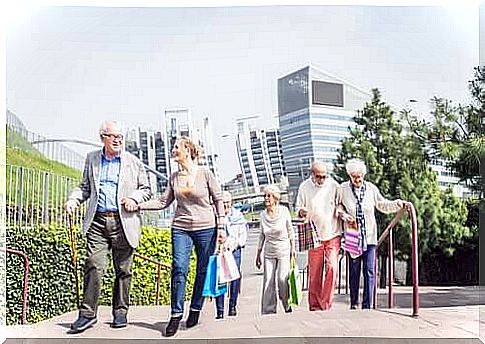Age-friendly Cities For More Well-being

People need contact with other people. Your surroundings can be very helpful because they not only influence how you interact with others, but also your ideas, emotions and behavior. A new concept is currently very trendy : age-friendly cities. These are living spaces that make it easier for people – regardless of their age – to interact with one another.
These cities can offer older people more opportunities to develop and contribute to the community. In this way they can maintain their dignity and autonomy. Age-friendly cities also make it easier for older people to lead a decent and safe life.
To create an age-friendly city, you need to make some changes and adapt it to the elderly. But why is it necessary? On the one hand, most places are not built for the elderly, which often prevents these people from developing and continuing to participate in community life. On the other hand, you should keep in mind that everyone gets older. Therefore, age-friendly cities will sooner or later benefit everyone.

Examples of age-friendly cities
There are currently various projects for age-friendly cities. In the United States, for example, the proportion of retirees continues to grow. There are places (like The Villages in Florida) that function like a network of villages with structures for the elderly. Can you imagine an all inclusive network?
Malta is a great example of an age friendly nation. This country specifically promotes the social integration of older people, because the goal is not only to adapt rooms and locations, but also to maintain the health of this population group. Therefore, Malta takes into account the following aspects:
- A share of the social and labor market for older people.
- The importance of their independence and autonomy and the creation of a friendly environment for those in need.
- Communities trained in dealing with issues such as dementia to provide specific care for these patients.
- Mental health measures.
In addition, age-appropriate cities promote integrative urban development. This allows all or most of the groups to interact in a city that suits their needs.
How can age-friendly cities improve your wellbeing?
Age-friendly cities are also called age-inclusive cities. These cities improve everyone’s wellbeing because in a community that values all of its residents, everyone feels valuable and needed. So everyone is involved and that creates good bonds, which is important for social health.
On the other hand, affective health also improves because the elderly feel closer to the community. And that’s great! Of course, that’s not the only thing you need for your emotional health, but it’s a good place to start.
In addition, age-friendly cities are committed to promoting general health by preventing disease. This means that you should think outside the box and look for ways you can improve your health. Because this guarantees you a better quality of life. In addition, there is already various research promoting diagnostic assessment to assess the degree of adaptation of cities to the elderly.

How to create more cities like this
Everyone counts in creating an age-friendly city. In order to promote and advance this idea, different areas should be considered:
- Job. The previous view of work needs to change so that older people can be integrated and given new opportunities.
- Education and knowledge. To learn more about how to develop in an assertive way to promote your own wellbeing.
- Financially. Age-friendly cities need a financial and economic system that is adapted to the needs of older people.
- Politically. Policies are needed that promote such cities, protect the elderly and take their needs into account.
- Urban. Development of spaces that promote integration.
Final thoughts
It is a job with many tasks to do in dealing with an increasingly aging population. The World Health Organization (WHO) reviews and supports such cities and provides official documents that can be used as a guide or guide to create these spaces in an efficient manner. For example, in her guide “Age-Friendly Cities” she encourages cities to participate in creating an age-friendly environment for people with greater difficulties.
In short, age-friendly cities are becoming more and more necessary due to our increasing life expectancy. Therefore everyone should do their part to ensure that there are more and more age-friendly cities.
But it’s not just about having no physical or mental barriers. Ultimately, it is also about our commitment to help people in need.








